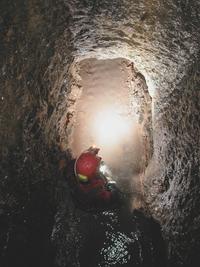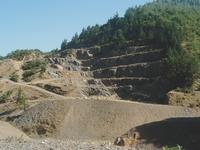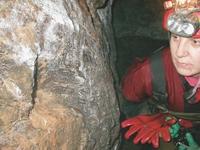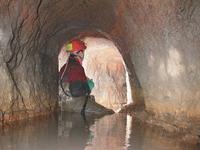Arditurri, source of wealth for centuries

A few years ago, few believed that the Roman Empire discovered the garrison on the coast of the Gulf of Bizkaia. But there is evidence like in the mines of Arditurri, in Aiako Harria (Oiartzun). The galleries and work tools found on the site show that they were exploited by the Romans.
In these mines they have worked until very recently. Therefore, in Arditurri they worked for at least two thousand years -- probably before the arrival of the Romans would exploit minerals or minerals. In 1984 the Real Compañía Asturiana de Minas stopped working in Arditurri. And the first Roman galleries were found before the mine was completely closed. Mertxe Urteaga and Txomin Ugalde were the authors of the discovery.
He runs the Mertxe Urteaga Arkeolan center and continues the work of recognition of the mines of Arditurri along with other archaeologists of Arkeolan and speleologists of the Félix Ugarte Association.
Roman remains
The entrance to this first gallery, full of bushes and the shadows of the hooks. At first glance it was just a hole. But after entering they realized that it was a Roman era, with the characteristics of its mines: a height of meter and eighty centimeters, an approximate width of meter... and with the remains of the piquita, on the walls. In fact, the Romans piquetted the walls of the mine.

Roman mining is also characterized by vaults of galleries such as half-barrel vaults, flat or intermediate vaults. In addition, on the walls there are small steps that were used to place the popcorn of light. This illuminated the road and work area.
The fire was very useful for these miners, not only for light, but also for opening steps. Heating facilitates rock crushing. This method is called roasting: with wood fire was made against the rock and when the rock was heated it broke. The piquette was then used to polish the walls. They worked fine.
In some places there have been found remains of the fires that used to make the passage, remains that have been stopped by not finding mineral veins and having abandoned the trial. However, the use of fire in that closed place required vents. On the other hand, in the galleries there was no need to accumulate water, and given that some galleries went under the river, to prevent the gallery from flooding the waters, the technique of drainage of cunicula (technique that the Romans learned to the Etruscans to dry the flooded land) was used. It was therefore a great engineering work that consisted in opening steps to look for a vein of minerals.
In search of the treasure
The Romans drew silver galena in Arditurri. Galena is a lead sulfide mineral (UpS) that often presents mixed silver. Therefore, lead had to be separated from silver. First they crushed the rock and selected the pieces with more minerals. Once these pieces were melted, a product was extracted that still mixed lead and silver. To distinguish them the barrel was used, that is, they were separated by oxidation. Lead and silver have different affinity for oxygen (lead oxidizes more easily than silver).
Presumably this process would take place near the mine. Therefore, around the mine a world was going to be gathered: engineers, miners, traders... and their families. It would be a people. Archaeologists have not yet found remains of this village, but are working on the treasure hunt.

However, it will not be easy to find the village of the mines of Arditurri, since the mining and accumulation of waste that has been carried out over the centuries have significantly altered the environment, including the riverbed itself.
In a broader perspective, Arditurri was inside a mining network. To bring the silver extracted to Rome it was necessary to set sail and it is believed that Arditurri was related to the port of Pasajes, but no trace has been found for the moment. If in Irun yes, there was a city called Oiasso (or Oarso) and there have appeared remains of the pier. In addition, Arditurri is not the only mine discovered in the area, but also exist in Lesaka and Bera (around the top of the granite there are such mineralizations, so the galleries are located along the entire round of Aiako Harria). It was undoubtedly a region of great movement.
Thalacker's footprint
It is difficult to determine its place in the Roman Empire of the Arditurri region. But the tracks gradually emerge and references to the Arditurri mines also appear in the literature. Some of them have not been taken into account until recently, when they have been shown with traces. An example of this is the report made in 1804 by engineer Johann Wilhelm Thalacker.
Thalacker, a collector in the Royal Cabinet of Natural History of Madrid, came to Arditurri to inspect the work being carried out in the mines, exploited by the Sein family of Oiartzun. Thalacker knew many of the Roman mines of the Iberian peninsula and thanks to this experience he wrote an extensive report on the mines of Arditurri. In that report, as to the importance of the mine, it equated those of Rio Tinto or León.

In 1905, in an article written by engineer Francisco de Gascue, he mentions that in Arditurri there were 15 kilometers of galleries. Thanks to them we know how the mines were. In fact, many of the steps taken by the Romans deteriorated: they were expanded to facilitate the work and, as the mining techniques changed, there was also an outdoor exploitation.
Thus, few remains of Roman exploitation have survived. Therefore, it is not surprising that the experts considered that Thalacker was wrong, describing other mines than those of Arditurri. This conviction spread throughout the last century, but the findings made by archaeologists in recent years show that Thalacker's work was very precise, as the galleries and remains found so far coincide with those described by him.
Arditurri shows
Arditurri is therefore more than a singular landscape, with centuries of history. In Roman times it gave silver, in the Middle Ages the iron (several ironworks in the riverbed of the Arditurri river) and until recently eleven other minerals have been extracted from the slopes of Aiako Harria. All this has influenced the lives of its people and is part of general history.
The Arkeolan people work to get to know this story in search of clues. And, on the other hand, as it is convenient to make this story known, the City of Oiartzun, under the protection of the Provincial Council of Gipuzkoa and the Basque Government, is about to build an interpretation center in Arditurri. It will be one of the accesses to the natural park of Aiako Harria. This interpretation center will explain the history of Arditurri and guided tours of the mines will take place, so whoever wishes can see with his own eyes the galleries open with the sweat of so many men.
Buletina
Bidali zure helbide elektronikoa eta jaso asteroko buletina zure sarrera-ontzian











